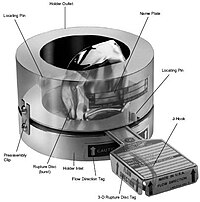Rupture disc
This article needs additional citations for verification. (October 2010) |

A rupture disc, also known as a pressure safety disc, burst disc, bursting disc, or burst diaphragm, is a non-reclosing pressure relief device that, in most uses, protects a pressure vessel, equipment or system from overpressurization or potentially damaging vacuum conditions.
A rupture disc is a type of sacrificial part because it has a one-time-use membrane that fails at a predetermined differential pressure, either positive or vacuum. The membrane is usually made out of metal,[1] but nearly any material (or different materials in layers) can be used to suit a particular application. Rupture discs provide instant response (within milliseconds) to an increase or decrease in system pressure, but once the disc has ruptured it will not reseal. It is not possible to set an accurate pressure value at which the disc will burst. Major advantages of the application of rupture discs compared to using pressure relief valves include leak-tightness and cost.
Rupture discs are commonly used in petrochemical, aerospace, aviation, defense, medical, railroad, nuclear, chemical, pharmaceutical, food processing and oil field applications. They can be used as single protection devices or as a backup device for a conventional safety valve; if the pressure increases and the safety valve fails to operate (or can't relieve enough pressure fast enough), the rupture disc will burst. Rupture discs are very often used in combination with safety relief valves, isolating the valves from the process, thereby saving on valve maintenance and creating a leak-tight pressure relief solution. It is sometimes possible, and preferable for highest reliability though at higher initial cost, to avoid the use of emergency pressure relief devices by developing an intrinsically safe mechanical design that provides containment in all cases.
Although commonly manufactured in disc form, the devices also are manufactured as rectangular panels (rupture panels or vent panels). Device sizes range from under 0.25 in (6 mm) to at least 3 ft (0.9 m), depending upon the industry application. Rupture discs and vent panels are constructed from carbon steel, stainless steel, hastelloy, graphite, and other materials, as required by the specific use environment.
Rupture discs are widely accepted throughout industry and specified in most global pressure equipment design codes (ASME, PED, etc.). Rupture discs can be used to specifically protect installations against unacceptably high pressures or can be designed to act as one-time valves or triggering devices to initiate with high reliability and speed a sequence of actions required.
Two main types
The dome is weakened by precision cut scores in the material during manufacturing, often using laser technology. So-called forward acting rupture discs have the overpressure on the concave side (inside) of the dome. Rupture of the membrane takes place when tensile forces exceed the ultimate tensile stress of the membrane material. Reverse acting rupture discs have the overpressure on the convex side (outside) of the dome. Stresses cause the dome to buckle after which it fails. The relevant material property that determines failure is the Young's modulus. Correct installation is essential. If installed upside down, the reliability of the overpressure safety device is compromised.[2]
Blowout panel
Blowout panels, also called blow-off panels, areas with intentionally weakened structure, are used in enclosures, buildings or vehicles where a sudden overpressure may occur. By failing in a predictable manner, they channel the overpressure or pressure wave in the direction where it causes controlled, directed minimal harm, instead of causing a catastrophic failure of the structure. Blow-off panels are used in ammunition compartments of some tanks to protect the crew in case of ammunition explosion, turning a catastrophic kill into mere firepower kill. An alternative example is a deliberately weakened wall in a room used to store compressed gas cylinders; in the event of a fire or other accident, the tremendous energy stored in the (possibly flammable) compressed gas is directed into a "safe" direction, rather than potentially collapsing the structure in a similar manner to a thermobaric weapon.
Military applications
Blowout panels are installed in several modern tanks, including the M1 Abrams, and have in the past been considered as a possible solution to magazine explosions on battleships.
In military ammunition storage, blowout panels are included in the design of the bunkers which house explosives. Such bunkers are designed, typically, with concrete walls on four sides, and a roof made of a lighter material covered with earth. In some cases this lighter material is wood, though metal sheeting is also employed. The design is such that if an explosion or fire in the ammunition bunker (also called a locker) were to occur, the force of the blast would be directed vertically, and away from other structures and personnel.
Applications in biology
Some models of gene gun also use a rupture disc, but not as a safety device. Instead, their function is part of the normal operation of the device, allowing for precise pressure-based control of particle application to a sample. In these devices, the rupture disc is designed to fail within an optimal range of gas pressure that has been empirically associated with successful particle integration into tissue or cell culture. Different disc strengths can be available for some gene gun models.
References
- ^ US Patent 2,630,939
- ^ "Large Steel Tank Fails and Rockets to Height of 30 meters - Rupture Disc Installed Incorrectly". doi:10.1016/j.shaw.2015.11.004.
{{cite journal}}: Cite journal requires|journal=(help)
External links
- Rupture disc sizing calculator to calculate discharge area requirement.
